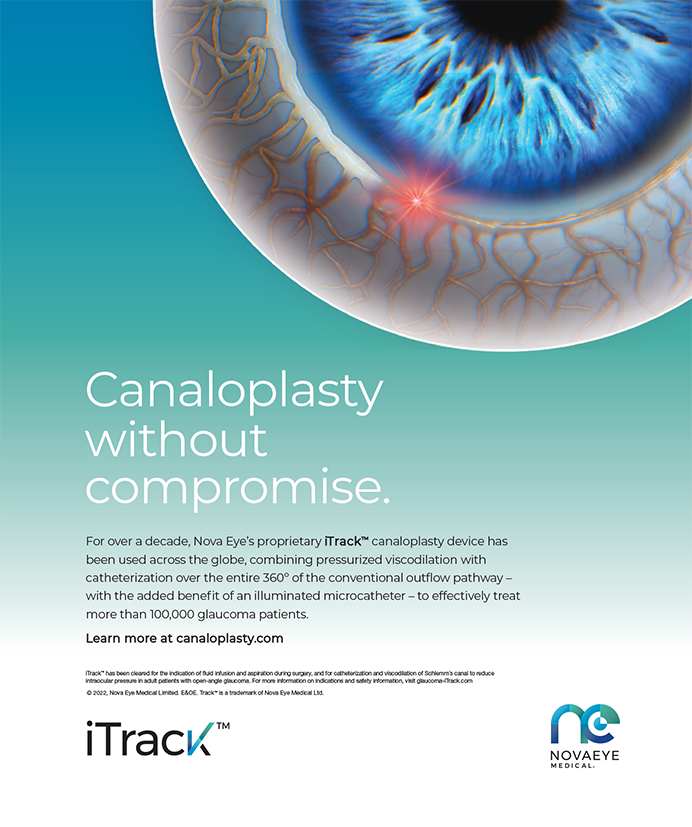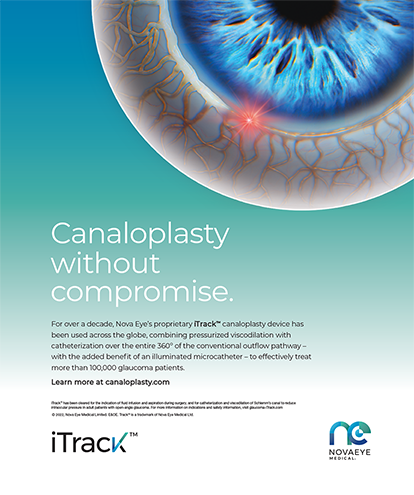Fixing the Overly Deep Anterior Chamber During Phacoemulsification
By Uday Devgan, MD
The anterior chamber can become excessively deep during cataract surgery in certain eyes, such as those with high myopia or those that previously underwent a pars plana vitrectomy (Figure). The cause is retropulsion of the lens-iris diaphragm, which occurs when the iris seals tightly against the anterior capsular rim, as explained by Cionni et al.1
Some surgeons have advocated lowering the bottle height in order to decrease the infusion pressure, but this measure can produce a fluid imbalance and destabilize the anterior chamber, placing the capsule at risk. Instead, the goal is to maintain an appropriate level of fluidic inflow while breaking this reverse pupillary block by either lifting the iris or depressing the anterior capsular rim. This surprisingly simple maneuver allows equilibration of the pressure between the anterior and posterior chambers, and the anterior chamber depth instantly returns to normal.
In my own cases, I like to use a chopper to gently lift the iris to equalize the anterior and posterior chamber pressures. When I am teaching, however, I have residents place a single iris hook to accomplish the same result. Nasal placement of the hook keeps it out of the way and prevents lens-iris diaphragm retropulsion syndrome from occurring during surgery.
Uday Devgan, MD, is in private practice at Devgan Eye Surgery, and he is chief of ophthalmology at Olive View UCLA Medical Center, both in Los Angeles. Dr. Devgan may be reached at (800) 337-1969; devgan@gmail.com.
- Cionni RJ, Barros MG, Osher RH. Management of lens-iris diaphragm retropulsion syndrome during phacoemulsification. J Cataract Refract Surg. 2004;30(5):953-956.
BETTER NUCLEOFRACTIS
By Thomas A. Oetting, MS, MD
Nucleofractis is the trickiest part of cataract surgery. Maybe for the first 50 cases, the capsulorhexis is harder, but with practice, it becomes routine. For more senior residents at the University of Iowa, most of the style points come with nucelofractis.
For years, I had believed that a second instrument (eg, Drysdale nucleus manipulator [Bausch + Lomb Storz]) was important to prevent the posterior capsule from coming forward when I was emulsifying chopped or divided segments. The pearl I describe herein was shared by Brian Little, FRCS, FRCOphth, when he came to Iowa City to visit our residents. He argued that any benefit from having a second instrument to protect the capsule is countered by the great disadvantage of having fluid flow out of the paracentesis around the second instrument. The lost fluid leaves the chamber less stable and creates eddies that disrupt flow directly to the tip.
At first, I was very reluctant to change. The Drysdale nucleus manipulator was my pacifier, security blanket, and good luck charm. I have no doubt now, however, that Brian was right. Removing the second instrument after segmentation creates a more stable chamber. All fluid flows directly to the tip and seems to magically pop each nuclear segment up onto the tip.
Videos on this subject are available on Dr. Oetting’s Facebook page at http://on.fb.me/1cDoJNM.
Thomas A. Oetting, MS, MD, is a clinical professor at the University of Iowa in Iowa City. Dr. Oetting may be reached at (319) 384-9958; thomas-oetting@uiowa.edu.
ADDRESSING THE INTUMESCENT CATARACT
By Tal Raviv, MD
Eyes with white cataracts and raised intralenticular pressure present a challenge because of the increased likelihood of a radialized capsulotomy. The rate of incomplete capsulotomies in eyes with white cataracts has been higher than 25% in some series.1,2 Multiple techniques have been advocated to achieve a complete capsular tear. They include pressurizing the anterior chamber with an ophthalmic viscosurgical device (OVD); decompressing released liquefied cortex with I/A; initiating the capsulorhexis with the phaco tip (I do not recommend this approach); performing a staged or two-step capsulorhexis, beginning with a miniature one1; and making the capsular tear with a cystotome or a needle (with simultaneous aspiration) via a sideport incision.
I have tried all of the aforementioned techniques, and none is a magic bullet. In fact, one of my recent cases seemed to defy all of these approaches and exhibited the Argentinean flag sign faster than I have ever seen. Despite complete pressurization of the anterior chamber with a dispersive OVD, full radialization occurred immediately after penetration of the capsule by the cystotome (Figure 1).
When later operating on this patient’s fellow eye, I punctured the OVD-flattened capsule via a small sideport incision (Figure 2A). (I had performed this step through the main incision when operating on the patient’s first eye.) Then, while maintaining pressurization of the anterior chamber, I performed bimanual I/A to remove the escaping liquefied cloud (Figure 2B). Despite apparent decompression, intralenticular pressure persisted, and I noticed that the capsulotomy tended to tear outward. The key technique for preventing an errant capsular tear was described by Brian Little, FRCS, FRCOphth.3 Specifically, the capsular flap is unfolded, and a (counterintuitive) pull in the opposite direction redirects the tear and allows for a continuous capsulotomy (Figure 2C). I advise all cataract surgeons to learn this technique.
It may be tempting in these cases to perform the capsulotomy with a femtosecond laser. Most reported laser cases achieve good capsulotomies in eyes with white cataracts. I did see one case involving an intumescent lens, however, in which laser treatment resulted in an uncontrolled tear and a chamber full of liquefied cortex. The intumescent lens is a challenge always best approached with all available tools and techniques.
Tal Raviv, MD, is an attending cornea and refractive surgeon at the New York Eye and Ear Infirmary and an assistant professor of ophthalmology at New York Medical College in Valhalla. He is also in private practice as a founding partner of New York Laser Eye in New York. Dr. Raviv may be reached at (212) 448-1005; tal.raviv@nylasereye.com.
- Newton K, Marcony RS, Kawakami A, et al. Mini-rhexis for white intumescent cataracts. Clinics (Sao Paulo). 2009;64(4):309-312.
- Chakrabarti A, Singh S. Phacoemulsification in eyes with white cataract. J Cataract Refract Surg. 2000;26:1041-1047.
- Little BC, Smith JH, Packer M. Little capsulorhexis tear-out rescue. J Cataract Refract Surg. 2006;32(9):1420- 1422.


